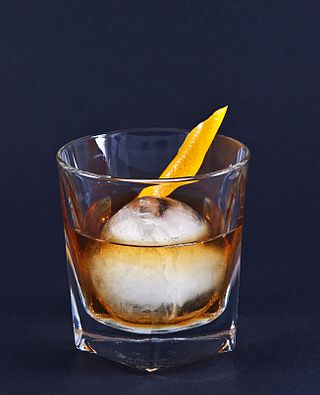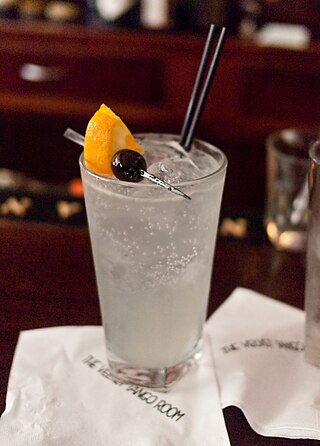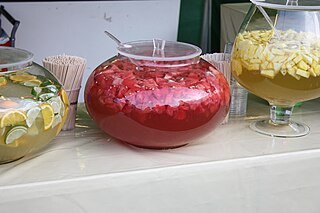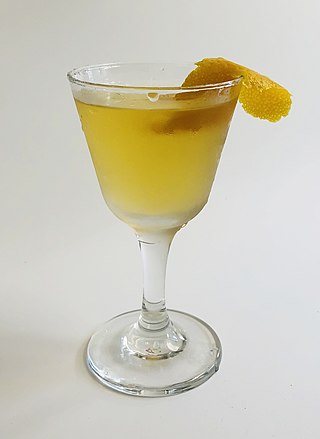
The old fashioned is a cocktail made by muddling sugar with bitters and water, adding whiskey, and garnishing with an orange slice or zest and a cocktail cherry. It is traditionally served with ice in an old fashioned glass.

The Tom Collins is a Collins cocktail made from gin, lemon juice, sugar, and carbonated water. First memorialized in writing in 1876 by Jerry Thomas, "the father of American mixology", this "gin and sparkling lemonade" drink is typically served in a Collins glass over ice. A non-alcoholic "Collins mix" mixer is produced, enjoyed by some as a soft drink.

French 75 is a cocktail made from gin, champagne, lemon juice, and sugar. It is also called a 75 Cocktail, or in French simply a Soixante Quinze.

The Sazerac is a local variation of a cognac or whiskey cocktail originally from New Orleans, named for the Sazerac de Forge et Fils brand of cognac brandy that served as its original main ingredient. The drink is most traditionally a combination of cognac or rye whiskey, absinthe, Peychaud's Bitters, and sugar, although bourbon whiskey is sometimes substituted for the rye and Herbsaint is sometimes substituted for the absinthe. Some claim it is the oldest known American cocktail, with origins in antebellum New Orleans, although drink historian David Wondrich is among those who dispute this, and American instances of published usage of the word cocktail to describe a mixture of spirits, bitters, and sugar can be traced to the dawn of the 19th century.

The sidecar is any cocktail traditionally made with cognac, orange liqueur, plus lemon juice. In its ingredients, the drink is perhaps most closely related to the older brandy crusta, which differs both in presentation and in proportions of its components.

The martini is a cocktail made with gin and vermouth, and garnished with an olive or a lemon twist. Over the years, the martini has become one of the best-known mixed alcoholic beverages. A popular variation, the vodka martini, uses vodka instead of gin for the cocktail's base spirit.

The term punch refers to a wide assortment of drinks, both non-alcoholic and alcoholic, generally containing fruits or fruit juice. The drink was introduced from the Indian subcontinent to England by employees of the East India Company in the late 17th century. Punch is usually served at parties in large, wide bowls, known as punch bowls.

A sour is a traditional family of mixed drinks. Sours belong to one of the old families of original cocktails and are described by Jerry Thomas in his 1862 book How to Mix Drinks.

The Prince of Wales is a cocktail created by Albert Edward, Prince of Wales, who later became King Edward VII. There are several variations of the cocktail, but what they usually have in common is champagne, angostura bitters, sugar, either rye whiskey or cognac, and a liqueur.

White lady is a classic cocktail that is made with gin, cointreau or Triple Sec, fresh lemon juice and an optional egg white. It belongs to the sidecar family, made with gin in place of brandy. The cocktail sometimes also includes additional ingredients, for example egg white, sugar, cream, or creme de menthe.

A "fizz" is a mixed drink variation on the older sours family of cocktail. Its defining features are an acidic juice and carbonated water. It typically includes gin or rum as its alcoholic ingredient.

The Alexander is a cocktail consisting of gin or brandy, cocoa liqueur, and cream. A variation, the Brandy Alexander, uses cognac instead of gin.

A Clover Club cocktail is a shaken cocktail consisting of gin, lemon juice, raspberry syrup, and egg white. The egg white acts as an emulsifier, forming the drink's characteristic foamy head.

The Malecon is a cocktail named after the El Malecón, the winding beachfront avenue atop the seawall in Havana, Cuba.
The corpse reviver family of named cocktails are sometimes drunk as alcoholic hangover tongue-in-cheek "cures", of potency or characteristics to be able to revive even a dead person. Some corpse reviver cocktail recipes have been lost to time, but several variations commonly thought to be tied to the American Bar at the Savoy Hotel remain, especially those espoused by Harry Craddock that originally date back to at least 1930 and are still being made. Many "reviver" variations exist and the word is sometimes used as a generic moniker for any morning-after cocktail, also known as a "hair of the dog".
The Blackthorn is an Irish whiskey or sloe gin based cocktail. Both versions emerged in the late 19th and early 20th century.
A Boomerang cocktail is a specific cocktail dating back to the early 20th century. In the 21st century, it may also be a reference to cocktails that bartenders illegally shuttle back and forth between bars as a way of sharing experimentation or building comradery.

The Chrysanthemum is a cocktail made with absinthe, Bénédictine, and vermouth. The pre-prohibition cocktail is sometimes credited to 1930 edition of The Savoy Cocktail Book, although an earlier recipe appears in the influential early 20th century cocktail book Recipes for Mixed Drinks (1916) by Hugo R. Ensslin.















